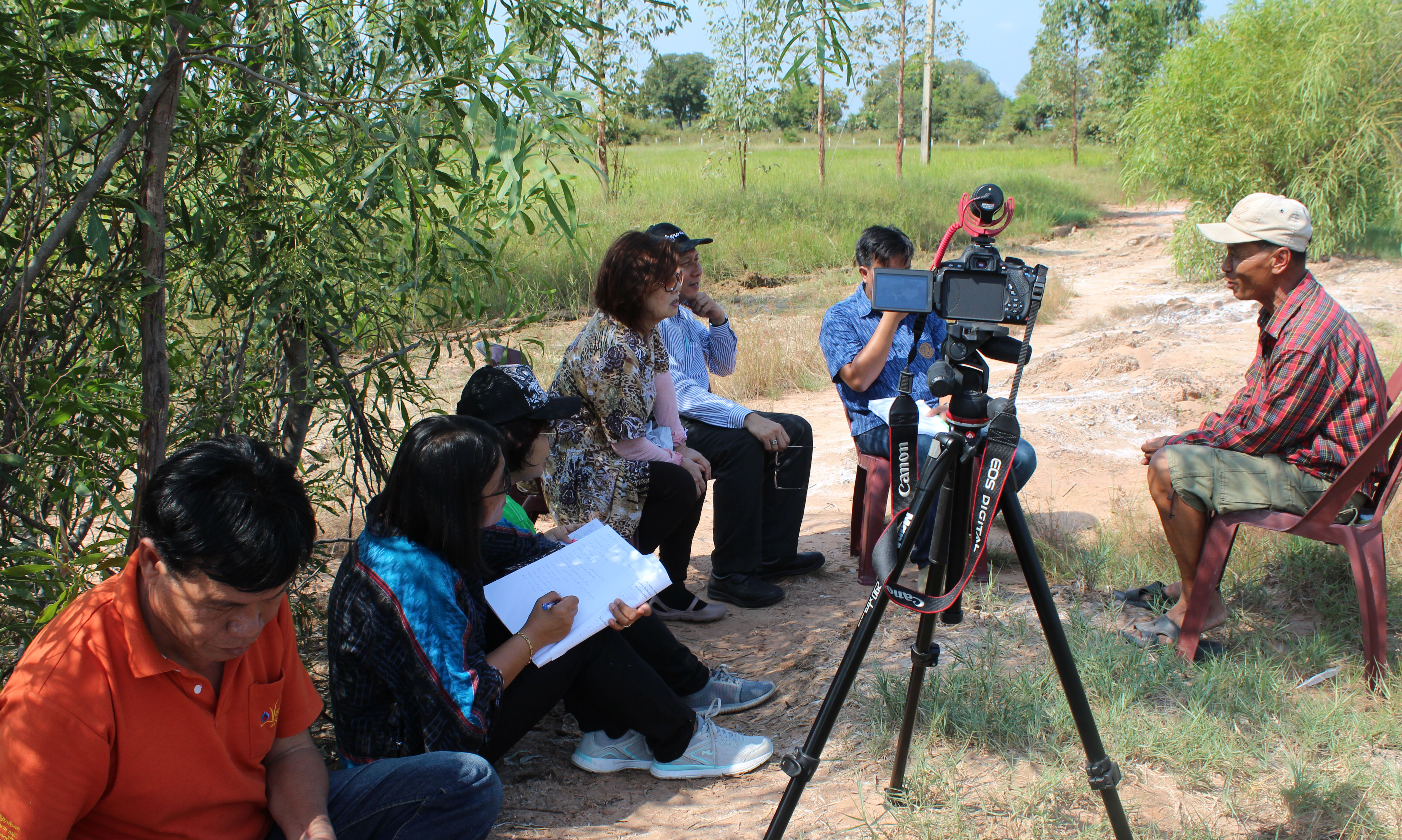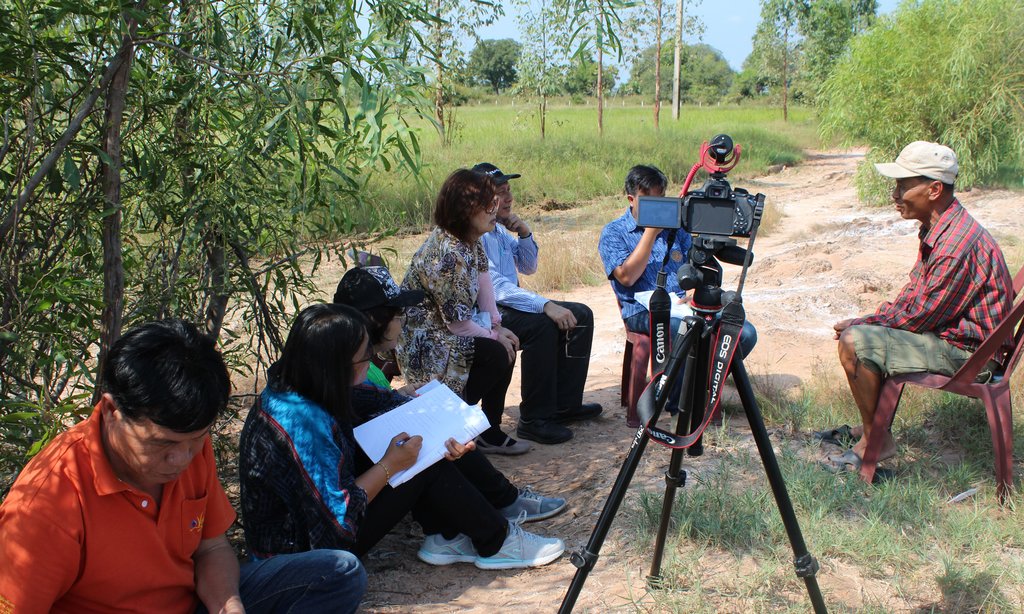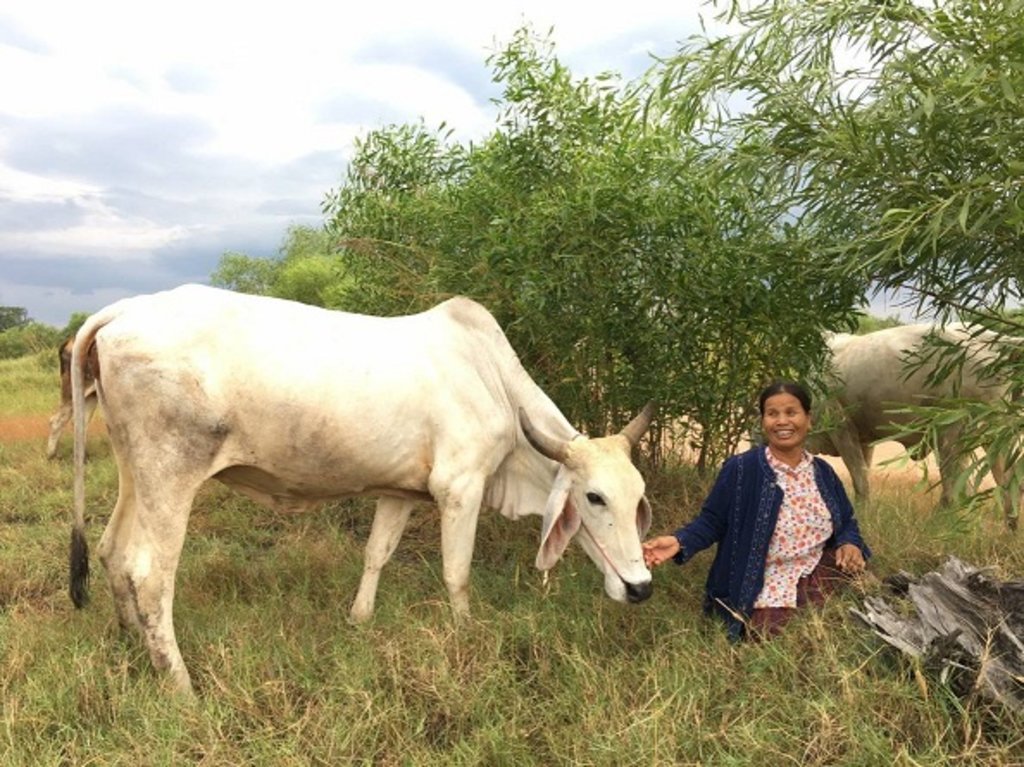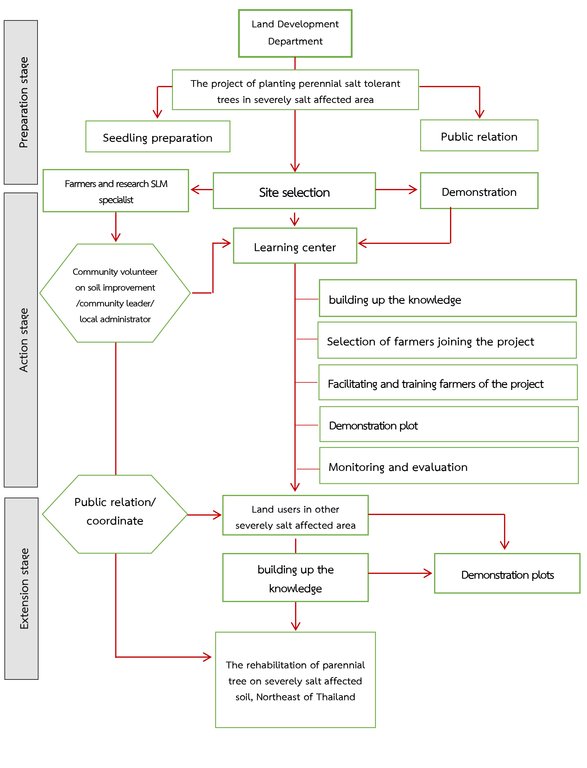Promotion of Acacia ampliceps rehabilitation on severely salt-affected soil [Tailândia]
- Criação:
- Atualização:
- Compilador/a: Phatranit Chuaysanoi
- Editor: –
- Revisores: Rima Mekdaschi Studer, Samran Sombatpanit, Alexandra Gavilano
Planting Acacia ampliceps on the severely salt-affected land.
approaches_4203 - Tailândia
Veja as seções
Expandir tudo Recolher tudo1. Informação geral
1.2 Detalhes do contato das pessoas capacitadas e instituições envolvidas na avaliação e documentação da abordagem
usuário de terra:
Tathaisong Nurean
+66-62-1521591
-
25 Ban Kok Sa-ard, Moo 10, T. Danchang, A. Buayai, Nakhon Ratchasima, Thailand
Tailândia
usuário de terra:
Panikom Chartee
+66-85-4395414
-
136/1 Moo 2, T. Danchang, A. Buayai, Nakhon Ratchasima
Tailândia
usuário de terra:
Salanok Mongkoen
+66-98-1181365
-
184 Moo 2, T. Danchang, A. Buayai, Nakhon Ratchasima
Tailândia
usuário de terra:
Palinee TubseKaew
+66-87-8706265
-
275 Moo 9, T. Danchang, A. Buayai, Nakhon Ratchasima
Tailândia
Soil doctor volunteer:
Ponrat Kumpu
+66-85-6308129
-
106 Moo 9, T. Danchang, A. Buayai, Nakhon Ratchasima
Assistant of village leader:
Pawanna Pakorn
+66-86-2586926
-
34 Moo 9, T. Danchang, A. Buayai, Nakhon Ratchasima
Especialista em GST:
Phaosrakhu Chakkaphan
+66-44-371397
yom42@hotmail.com
Technical Group for Land Development, Land Development Regional Office 3, Land Development Department
64 Moo 7, T. Joho, A. Muang, Nakhon Ratchasima 30310
Tailândia
Especialista em GST:
Oechaiyaphum Kaewjai
+66-83-5429245
issabellalala@gmail.com / KuKaewKaLDD@gmail.com
Chaiyaphum Land Development Station
268/5 Moo 14, T. Na Fai, A. Muang, Chaiyaphum
Tailândia
Especialista em GST:
Prachansri Saowanee
+66-44-371354
prachansri@gmail.com
Land Development Regional Office 3, Land Development Department
64 Moo 7, T. Joho, A. Muang, Nakhon Ratchasima 30310
Tailândia
Especialista em GST:
Phiprakon Apisit
+66-44-371397
Technical Group for Land Development, Land Development Regional Office 3, Land Development Department
64 Moo 7, T. Joho, A. Muang, Nakhon Ratchasima 30310
Tailândia
Especialista em GST:
Prawanna Prasit
+66-44-371397
Technical Group for Land Development, Land Development Regional Office 3, Land Development Department
64 Moo 7, T. Joho, A. Muang, Nakhon Ratchasima 30310
Tailândia
National Consultant:
Arunin Somsri
ssarunin@gmail.com
Land Development Department
2003, 61 Phaholyothin Road, Ladyao, Chatuchak, Bangkok 10900
Tailândia
Especialista em GST:
Nome do projeto que facilitou a documentação/avaliação da Abordagem (se relevante)
Decision Support for Mainstreaming and Scaling out Sustainable Land Management (GEF-FAO / DS-SLM)Nome da(s) instituição(ões) que facilitou(ram) a documentação/avaliação da Abordagem (se relevante)
Land Development Department LDD (Land Development Department LDD) - Tailândia1.3 Condições em relação ao uso da informação documentada através de WOCAT
Quando os dados foram compilados (no campo)?
09/10/2018
O/a compilador/a e a(s) pessoa(s) capacitada(s) aceitam as condições relativas ao uso de dados documentados através da WOCAT:
Sim
2. Descrição da abordagem de GST
2.1 Descrição curta da abordagem
Planting perennial salt-tolerant trees in the severely salt-affected area in Lam Satad of Chi-Mun watershed was induced by the Land Development Department at A. Buayai, Nakhon Ratchasima. This project aimed at the extension of planting Acacia ampliceps through demonstration plot of 4,665 rai or 746.4 ha (1 ha = 6.25 rai).
2.2 Descrição detalhada da abordagem
Descrição detalhada da abordagem:
The rehabilitation of Acacia ampliceps on severely salt-affected soils has been the subproject of the LDD project on "Planting Perennial Salt-tolerant Trees in Salt-affected Areas in the Northeast of Thailand", which started since 1996. The area of Acacia ampliceps has extended larger than 10,000 rai through public relations, demonstration plots, a collaboration of community leaders, local governmental administration, community volunteers on soil improvement and land users.
The soil salinity map (LDD, 1995) shows the severely salt-affected land in Northeast Thailand occupies 475,204 rai. One of the technologies to decrease the salinity is to decrease the saline shallow groundwater level by planting salt-tolerant trees which are low input compared with engineering measures. The LDD has been extensively planting Acacia ampliceps through close collaboration and participation of stakeholders and demonstration plots in many severely salt-affected locations of several sub-watersheds, one of the sites being Lam Satad of Chi-Mun watershed. The objectives of the approach are (1) to extend the area of planting Acacia ampliceps to prevent and decrease salination, (2) to maximize the use of salt-affected land for a better environment and crop production, and (3) to extend the knowledge of vegetative measure for salinity control to land users and laymen.
The methods used are through (1) demonstration plot of the technology which is planting Acacia ampliceps of 2-month-old seedlings in the pit of 0.3x0.3x0.3 m as the single row on the 2 m wide, 0.5 m high bed, the top of the bed being 1.5 m wide and the number of plants per rai is 80; (2) the land users got to know the approach by public relations media, local administration, community soil doctor volunteer on soil improvement, community leaders, SLM specialists, and researchers; (3) selection of interested land users under LDD requirement is processed; (4) training of selected land users after joining the project, and (5) monitoring and evaluation is done after 1 year of planting.
Stakeholders involved are LDD researchers and SLM specialists responsible for establishing planting method, preparation of land (land leveling and beds for planting), production of seedlings and carrying out demonstration plots, as well as monitoring and evaluation and training at the beginning of planting in new areas. The local administration, community soiil doctor volunteers on soil improvement are involved in public relations, recommendations, and strengthening closer participation among farmers. Land users/farmers are to be trained and instructed to follow the technology by SLM specialists. They are also to participate in the monitoring and evaluation and persuade other land users/farmers to plant Acacia ampliceps.
The land users/farmers favour the project because they had observed that salinity could be controlled and they utilize the trees as a shade for cattle and the tree branches for producing charcoal. Besides, the land users are self-organized as a group to watch the young trees from stumbling by cattle. The disadvantage of Acacia ampliceps is its sensitivity to flash flood and forest fire. Furthermore, the production from trees is not sufficient socially and economically.
2.3 Fotos da abordagem
Observações gerais sobre as fotos:
This picture shows a group of Land Development Department officers, land users and any stakeholders during knowledge-sharing process through meeting and discussion.
2.4 Vídeos da abordagem
Comentários, breve descrição:
Conversation and lesson learned
Data:
09/10/2018
Localização:
Ban Nong Mek T. Danchang, A. Buayai, Nakhon Ratchasima
Nome do cinegrafista:
Jilayus Sommutram
2.5 País/região/locais onde a abordagem foi aplicada
País:
Tailândia
Região/Estado/Província:
Nakhon Ratchasima
Especificação adicional de localização:
Ban Kok Sa-ard, Moo 10 T. Danchang, A. Buayai
Comentários:
The approach has been applied at Ban Kok Sa-ard M. 10 T. Danchang, A. Buayai, Nakhon Ratchasima
Map
×2.6 Datas de início e término da abordagem
Indique o ano de início:
2014
Caso o ano exato seja desconhecido, indique a data aproximada de início da abordagem:
menos de 10 anos atrás (recentemente)
Ano de término (caso a abordagem não seja mais aplicada):
2017
Comentários:
This approach has been used since 2014 until now.
2.7 Tipo de abordagem
- Baseado em projeto/programa
2.8 Principais metas/objetivos da abordagem
The purpose is to scale-out the approach to persuade farmers on severely salt-affected land in other districts and provinces to grow Acacia ampliceps.
2.9 Condição que propiciam ou inibem a implementação de tecnologia/tecnologias aplicada(s) segundo a abordagem
Normas e valores sociais/culturais/religiosos
- Propício
Farmers have mutual respect for the community leader and for each other.
Disponibilidade/acesso a recursos e serviços financeiros
- Propício
Farmers can access the financial resources through the housing fund.
Quadro institucional
- Propício
Public relations is done by Sub-district Administration Organization (SAO).
Colaboração/coordenção de atores
- Propício
Community leaders, soil doctors (soil improvement volunteers) and successful farmers are working together.
Políticas
- Propício
Thai government has the policy in rehabilitating salt-affected soils.
Conhecimento sobre GST, acesso a suporte técnico
- Propício
LDD officers educate farmers in study areas.
3. Participação e papel das partes interessadas envolvidas
3.1 Partes interessadas envolvidas na abordagem e seus papéis
- Usuários de terra/comunidades locais
The LDD officers, community leader, soil doctors (soil improvement volunteers) and local administration officers.
Provide knowledge of the technology.
- Especialistas em GST/ consultor agrícola
SLM specialist, community leader, soil doctors (soil improvement volunteers) and local administration officers.
Technology transfer and implementation
- Governo local
Local administration / Community leader
Public relations and coordination
Caso várias partes interessadas foram envolvidas, indique a agência líder:
TThe LDD officers had extensively worked through close collaboration and participation of community leader, soil doctors (soil improvement volunteers) and local administration officers.
3.2 Envolvimento do usuários de terra/comunidades locais nas diferentes fases da abordagem
| Envolvimento do usuários de terra/comunidades locais | Especifique quem estava envolvido e descreva as atividades | |
|---|---|---|
| Iniciação/motivação | Passivo | Training and demonstration plot was held in the study area. |
| Planejamento | Participativo | Public hearing planning was set up before the beginning of the project. |
| Implementação | Apoio externo | Some farmers were hired labourers in this project. |
| Monitoramento/avaliação | Participativo | Volunteer soil doctors and community volunteers were in charge of the coordination. |
3.3 Fluxograma (se disponível)
Descrição:
Flow chart shows three phases of the implementation and approach.
Autor:
Mrs. Phatranit Chuaysanoi
3.4 Decisão sobre a seleção de tecnologia/tecnologias de GST
Especifique quem decidiu sobre a seleção de tecnologia/tecnologias a serem implementadas:
- Principalmente especialistas em GST, após consulta com usuários da terra
Explique:
LDD started to do demonstration plot and educate farmers in 2014.
Especifique em que base foram tomadas as decisões:
- Avaliação de conhecimento bem documentado de GST (tomada de decisão baseada em evidências)
4. Suporte técnico, reforço das capacidades e gestão do conhecimento
4.1 Reforço das capacidades/ formação
Foi oferecida formação aos usuários da terra/outras partes interessadas?
Sim
Especifique quem foi capacitado:
- Usuários de terra
Caso seja relevante, especifique gênero, idade, status, etnia, etc.
Mrs. Nurean Tathaisong, female, 56 years old, married, Thai
Tipo de formação:
- Áreas de demonstração
Assuntos abordados:
The rehabilitation of severely salt-affected soils by growing Acacia ampliceps could reduce household expenditure and is easy to follow.
Comentários:
Mrs. Nurean Thathaisong, female, 56 years old, married, Thai, has been playing an important role as a land user who received training and operated demonstration areas since 2014.
4.2 Serviço de consultoria
Os usuários de terra têm acesso a um serviço de consultoria?
Sim
Especifique se foi oferecido serviço de consultoria:
- nas áreas dos usuários da terra
Descreva/comentários:
1. LDD officers educate farmers in the study area.
2. There is cooperation among community leader, volunteer soil doctors (soil improvement volunteers) and successful farmers.
4.3 Fortalecimento da instituição (desenvolvimento organizacional)
As instituições foram fortalecidas ou estabelecidas através da abordagem?
- Não
4.4 Monitoramento e avaliação
Monitoramento e avaliação são partes da abordagem?
Sim
Comentários:
LDD officers are in charge of monitoring, investigating survival rates and planning for reparation in the next cropping season.
Caso afirmativo, esta documentação é destinada a ser utilizada para monitoramento e avaliação?
Sim
Comentários:
There are many issues in a document, which should be used for monitoring and evaluation.
4.5 Pesquisa
A pesquisa foi parte da abordagem?
Sim
Especifique os tópicos:
- Tecnologia
Dê mais detalhes e indique quem realizou a pesquisa:
LDD researchers
5. Financiamento e apoio material externo
5.1 Orçamento anual para o componente de GST da abordagem
Caso o orçamento exato seja desconhecido, indique a faixa:
- < 2.000
Comentários (p. ex. principais fontes de recursos/principais doadores):
Land Development Department
5.2 Apoio financeiro/material concedido aos usuários da terra
Os usuários da terra receberam apoio financeiro/material para a implementação de tecnologia/tecnologias?
Sim
Caso afirmativo, especifique tipo(s) de apoio, condições e fornecedor(es):
Cost of compost, fertilizer, rice husk, Acacia ampliceps young seedlings
5.3 Subsídios para entradas específicas (incluindo mão-de-obra)
- Mão-de-obra
| Em que medida | Especifique os subsídios |
|---|---|
| Totalmente financiado | Plantation and maintenance |
- Agrícola
| Especifique quais entradas foram subsidiadas | Em que medida | Especifique os subsídios |
|---|---|---|
| Sementes | Totalmente financiado | Free young seedlings |
| Fertilizantes | Totalmente financiado | Free compost, rice husk and chemical fertilizer with 15-15-15 formula |
- Construção
| Especifique quais entradas foram subsidiadas | Em que medida | Especifique os subsídios |
|---|---|---|
| farm rigged | Totalmente financiado | Reshape of farm ridge |
Comentários:
There were many subsidies such as labour, agricultural inputs, and construction material, which are free for farmers who engaged in this project.
5.4 Crédito
Foi concedido crédito segundo a abordagem para atividades de GST?
Não
5.5 Outros incentivos ou instrumentos
Foram utilizados outros incentivos ou instrumentos para promover a implementação das tecnologias de GST?
Não
6. Análise de impactos e declarações finais
6.1 Impactos da abordagem
A abordagem concedeu autonomia aos usuários locais de terra, melhorou a participação das partes interessadas?
- Não
- Sim, pouco
- Sim, moderadamente
- Sim, significativamente
To develop food security and reduce farm household
A abordagem propiciou a tomada de decisão baseada em evidências?
- Não
- Sim, pouco
- Sim, moderadamente
- Sim, significativamente
Learning center and source of information in the decision-making process on technology adoption
A abordagem auxiliou os usuários da terra a implementar e manter as tecnologias de GST?
- Não
- Sim, pouco
- Sim, moderadamente
- Sim, significativamente
Farmers were taking care of technology because it causes of expenditure reduction
A abordagem mobilizou/melhorou o acesso aos recursos financeiros para implementação da GST?
- Não
- Sim, pouco
- Sim, moderadamente
- Sim, significativamente
It would be a guarantee for loan deposit
A abordagem aprimorou o conhecimento e as capacidades dos usuários da terra para implementar a GST?
- Não
- Sim, pouco
- Sim, moderadamente
- Sim, significativamente
Self-adaptation and changing of SLM patterns
A abordagem aprimorou o conhecimento e as capacidades de outras partes interessadas?
- Não
- Sim, pouco
- Sim, moderadamente
- Sim, significativamente
Government agencies and the private sector development patterns of SLM
A abordagem resultou em acesso melhorado à água e ao saneamento?
- Não
- Sim, pouco
- Sim, moderadamente
- Sim, significativamente
According to technology adoption, it could result in desalinization and income enhancement
6.2 Principal motivação dos usuários da terra para implementar a GST
- Produção aumentada
Increase of arable land
- Degradação do solo reduzida
Desalinization
- Carga de trabalho reduzida
Increase of pasture land
6.3 Atividades de sustentabilidade de abordagem
Os usuários da terra podem manter o que foi implementado através da abordagem (sem apoio externo)?
- Sim
Caso afirmativo, descreva como:
Most farmers have a good understanding of the rehabilitation of Acacia ampliceps on severely salt-affected soils. Moreover, farmers can get benefit of expenditure reduction through utilization of tree branches as charcoal.
6.4 Pontos fortes/vantagens da abordagem
| Pontos fortes/vantagens/oportunidades na visão do usuário da terra |
|---|
| 1) Acacia ampliceps is a perennial salt-tolerant tree, which can grow well in the severely salt-affected area. |
| 2) Desalinization resulted from Acacia ampliceps plantation after 2 years of planting, native grasses return and become grazing land. |
| 3) Tree branches of Acacia ampliceps could be utilized as charcoal; acacia leaves fallen on the soil revive soil properties and the land was changed from barren to trees that become shading. |
| 4) Soil doctors (soil improvement volunteers) were in charge of coordination. |
| Pontos fortes/vantagens/oportunidades na visão do/a compilador/a ou de outra pessoa capacitada |
|---|
| 1) There were LDD officers working with a community leader, soil doctors (soil improvement volunteers) and SAO (Sub-district Administration Organization) officers, who can suggest and support necessary information to the farmer. |
| 2) Land Development Department operates demonstration plots. |
6.5 Pontos fracos, desvantagens da tecnologia e formas de superá-los
| Pontos fracos/desvantagens/riscos na visão do usuário da terra | Como eles podem ser superados? |
|---|---|
| 1) If a farmer does not engage with this project, he will have no knowledge how to plant Acacia ampliceps on the farm ridge. Moreover, he will not know where to buy Acacia ampliceps seeds. | The LDD has extensively worked through close collaboration and participation of community leader, soil doctors (soil improvement volunteers) and local administration officers on public relations and persuade other land users/ farmers to plant Acacia ampliceps. |
| Pontos fracos/vantagens/riscos na visão do/a compilador/a ou de outra pessoa capacitada | Como eles podem ser superados? |
|---|---|
| 1) If a farmer doesn’t engage with this project, they don’t have knowledge how to desalinization by planting Acacia ampliceps. Moreover, they don’t know that severely salt-affected soils become less saline to become rice field after 3 years of planting Acacia ampliceps. | There must have training/ suggesting farmers to know the benefits of Acacia ampliceps planting. |
7. Referências e links
7.1 Métodos/fontes de informação
- entrevistas com usuários de terras
Six persons about Acacia ampliceps plantation
- entrevistas com especialistas em GST
Seven LDD officers
7.2 Referências às publicações disponíveis
Título, autor, ano, ISBN:
Land Development Department
Disponível de onde? Custos?
http://www.ldd.go.th/
7.3 Links para informação relevante que está disponível online
Título/ descrição:
Where the land is greener - Case Studies and Analysis of Soil and Water Conservation Initiatives Worldwide
URL:
http://www.ldd.go.th/www/lek_web/
Links e módulos
Expandir tudo Recolher tudoLinks
Não há links
Módulos
Não há módulos







